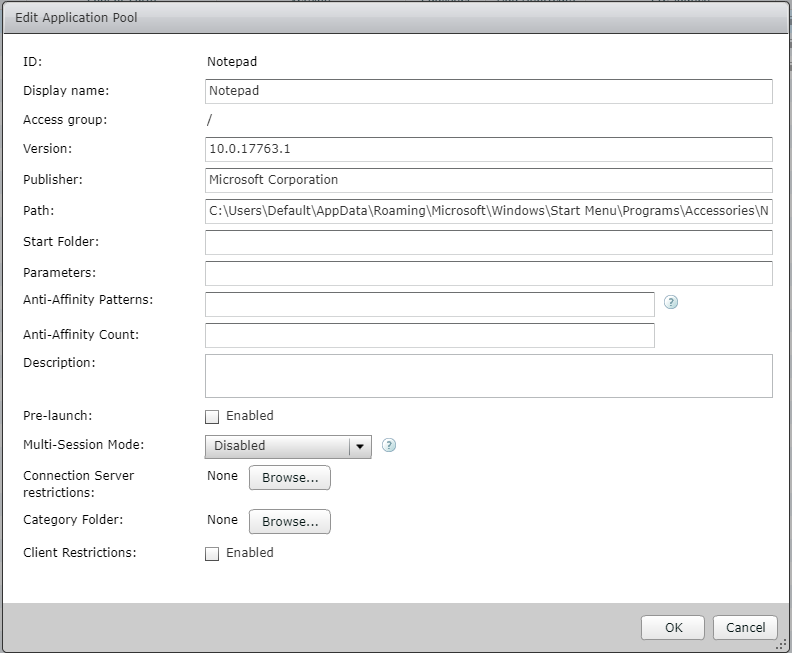VMware Horizon Delivery Methods
Overview
AppsAnywhere supports delivering both applications and desktops via VMware Horizon, utilising either the native VMware Horizon Client or in the web browser via HTML5 Access when configured.
Before you start
To work with VMware Horizon, you must first Add an VMware Horizon Environment.
All delivery methods share some basic, common settings that you will need to understand before continuing. Make sure you have read the Common Delivery Method Settings article before continuing.
Once you understand the common settings and how they work, you can go to the application you want to manage:
From the AppsAnywhere admin portal, search for Applications, or go to Applications > Applications in the navigation menu
Click Edit next to the application you wish to manage
Application Delivery Methods
There are two delivery methods available for delivering applications via VMware Horizon. You will see this when Adding delivery methods to an app if you select the VMware category from the left-hand side of the Add New Delivery Method dialog.
The delivery method fields are described in detail in this section.
VMware Horizon: Native
The VMware Horizon: Native application delivery method uses the VMware Horizon client on the user’s device to launch a resource that is a natively installed published application within the Horizon environment.
The following table describes each field and setting available when creating this type of delivery method, it's intended value, and an example for each.
Field Name | Description | Example |
|---|---|---|
Internal display name | A common field across all delivery methods, allowing you to assign a friendly name to the delivery method for your own reference. Optional: When empty the the display name will be automatically generated from the Resource name field value. | |
Launch button text | The text you wish to appear on the launch button when this delivery method is used Optional: When empty the default Launch button text ‘Launch’ will be used. | |
Horizon environment | A list of currently configured VMware Horizon Environments. Select the appropriate environment from the list which the published application is defined within. | Horizon Server 1 |
Resource name | The exact value of the "Display name" field for the published application. When applications are defined within the Horizon Admin portal, the "Display name" is specified. You must enter this value exactly as it appears in VMware Horizon. | Notepad  Screenshot of the Horizon Admin showing an example published application and the “Display name” field. |
Connect USB on startup? | Enables or disables the ability to automatically connect the USB devices attached to the user's device to the Horizon session on startup if available. | Enabled |
Connect USB on insert? | Enables or disables the ability to automatically connect USB devices when they are inserted into the user's device to the Horizon session if available. | Enabled |
Protocol | The protocols that will be used to establish the Horizon session. PCoIP is the default but Blast can also be selected/used if required. Please note that if the selected protocol is not available when the connection attempt is made it will fallback to use a protocol that is available. | PCoIP |
Enable unauthenticated access? | Enables or disables the use of unauthenticated access to the Horizon session. | Disabled |
Unauthenticated access account | The access account name used for unauthenticated access request. This field is only available if the Enable unauthenticated access? option is enabled. | |
Single instance (use existing)? | Enables or disables the use of a single and/or existing Horizon session/connection the user may already have established. This is enabled by default and the preferred behaviour in most environments. This option will only function is multi-session mode is enabled/disabled within the Horizon published application settings. | Enabled |
Arguments (passed to remote application) | Command line arguments that will be passed to the Horizon published application at the time of launch. Arguments should be enclosed in double quotes. | “/A filename.txt” |
VMware Horizon: Cloudpaged
The VMware Horizon: Cloudpaged delivery method uses the VMware Horizon client on the user’s device to launch a remote VMware Horizon session that then triggers the AppsAnywhere Client within that session to launch a Cloudpaged app on the remote session host. If the app has not been launched on that session host before then it will be delivered to it when the user initiates the session.
This process can be a little bit confusing as the AppsAnywhere Client is involved twice, both on the user's device and on the remote server, so let's break it down:
The user clicks launch in the browser and a message is sent to the AppsAnywhere Client running on the user's device
The AppsAnywhere Client on the user's device, first of all, makes sure that the VMware Horizon Client is installed and then initiates an application session
Once the session is initiated, a message is passed from the AppsAnywhere Client on the user's device to the AppsAnywhere Client running on the remote session host with details about which Cloudpaged app needs to be launched
The AppsAnywhere Client on the remote session host streams the app onto that server via Cloudpaging Player and then presents it to the user through the session
You will need a number of things in place before you can create this kind of delivery method:
Publish the AppsAnywhereLauncher as a published resource in your VMware Horizon environment
The AppsAnywhere Launcher will need to be added manually to the application pool. The Path value required for the AppsAnywhere Launcher is :
AppsAnywhere Client 1.x: C:\Program Files\Software2\AppsAnywhere\AppsAnywhereLauncher.exe
AppsAnywhere Client 2.x: C:\Program Files\AppsAnywhere\AppsAnywhere\AppsAnywhereLauncher.exe
You must also entitle the published application via the Horizon Admin to any groups or individual users who you wish to use this delivery mechanism.
Install CloudPaging Player on the remote session host.
After the AppsAnywhere launcher has been added to your Horizon environment, you will need to install the CloudPaging Player (see article: Managed Deployment of AppsAnywhere Client and Cloudpaging Player (by GPO or SCCM)) to allow the launch of Cloudpaged Applications.
Note: The RDS Host(s) and or desktop pool(s) instances MUST have the AppsAnywhere Client installed. The Software2 Client Startup Task and Software2 Updater Task must also be disabled in the Windows Task Scheduler.
You will need to have already created a Cloudpaging delivery method for this app which links in the package you want to deliver onto the server
The Cloudpaging delivery method must be set with Windows Server OS compatibility (so it runs on the RDSH servers)
The configuration options for this delivery method are similar to those for the VMware Horizon: Native delivery method. The following table describes each additional field and setting available when creating this type of delivery method, it's intended value, and an example for each.
Field Name | Description | Example |
|---|---|---|
Resource name For the VMware Horizon: Cloudpaged delivery method, this field requires a specific value. | The exact value of the “Display name” field for the “AppsAnywhereLauncher” application as published within the Horizon environment. In order to use the VMware Horizon: Cloudpaged delivery method, the AppsAnywhere Launcher must be defined as a published application within the Horizon environment. When publishing the AppsAnywhere Launcher via the Horizon Admin it is advisable to use the default "AppsAnywhereLauncher" display name if possible. | AppsAnywhereLauncher  Screenshot of the Horizon Admin showing the published “AppsAnywhereLauncher” application. |
| This field is not available on the VMware Horizon: Cloudpaged delivery method. | |
Cloudpaging delivery method | The Cloudpaging delivery method that will be launched within the remote session. You can select any Cloudpaging delivery method that is associated with the current application. If this list is empty, please first create a Cloudpaging Delivery Method for the current application. | “Cloudpaging delivery method display name [ID]” |
Desktop Delivery Methods
There a single delivery method available for delivering a desktop via VMware Horizon. You will see this when Adding delivery methods to an desktop if you select the VMware category from the left-hand side of the Add New Delivery Method dialog.
The delivery method fields are described in detail in this section.
VMware Horizon: Desktop
The VMware Horizon: Native application delivery method launches a resource that is a natively installed published application within the Horizon environment.
The following table describes each field and setting available when creating this type of delivery method, it's intended value, and an example for each.
Field Name | Description | Example |
|---|---|---|
Internal display name | A common field across all delivery methods, allowing you to assign a friendly name to the delivery method for your own reference. Optional: When empty the the display name will be automatically generated from the Resource name field value. | |
Launch button text | The text you wish to appear on the launch button when this delivery method is used Optional: When empty the default Launch button text ‘Launch’ will be used. | |
Horizon environment | A list of currently configured VMware Horizon Environments. Select the appropriate environment from the list which the published desktop pool is defined within. | Horizon Server 1 |
Resource name | The exact value of the "Display name" field for the published desktop pool. When applications are defined within the Horizon Admin portal, the "Display name" is specified. You must enter this value exactly as it appears in VMware Horizon. | Notepad  Screenshot of the Horizon Admin showing an example published application and the “Display name” field. |
Connect USB on startup? | Enables or disables the ability to automatically connect the USB devices attached to the user's device to the Horizon session on startup if available. | Enabled |
Connect USB on insert? | Enables or disables the ability to automatically connect USB devices when they are inserted into the user's device to the Horizon session if available. | Enabled |
Protocol | The protocols that will be used to establish the Horizon session. PCoIP is the default but Blast can also be selected/used if required. Please note that if the selected protocol is not available when the connection attempt is made it will fallback to use a protocol that is available. | PCoIP |
Enable unauthenticated access? | Enables or disables the use of unauthenticated access to the Horizon session. | Disabled |
Unauthenticated access account | The access account name used for unauthenticated access request. This field is only available if the Enable unauthenticated access? option is enabled. | |
Single instance (use existing)? | Enables or disables the use of a single and/or existing Horizon session/connection the user may already have established. This is enabled by default and the preferred behaviour in most environments. This option will only function is multi-session mode is enabled/disabled within the Horizon published application settings. Multi-Session mode is disabled by default in the Horizon published application settings and default selection in AppsAnywhere mimics this behaviour. | Enabled |
Layout | The screen layout of the Horizon session | Full screen |
Custom layout size | Defines the custom screen size if required. This field is only available if the Layout option is set to “Window (custom)”. | |
Kiosk Mode (unattended) | Enables or disables the use of the Horizon Client kiosk mode feature. | Disabled |
